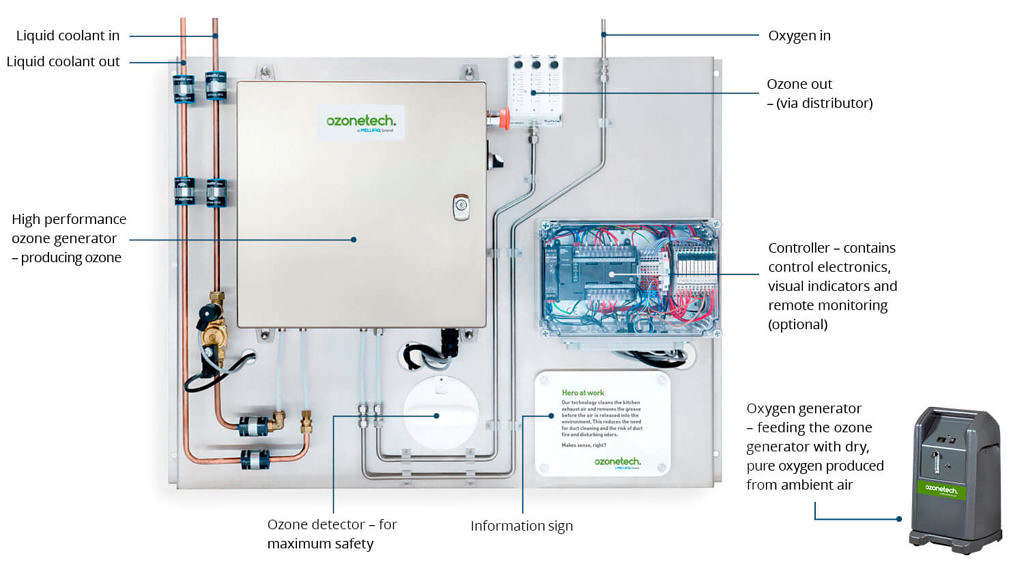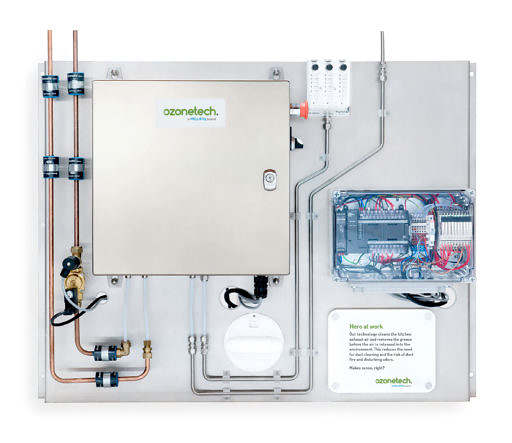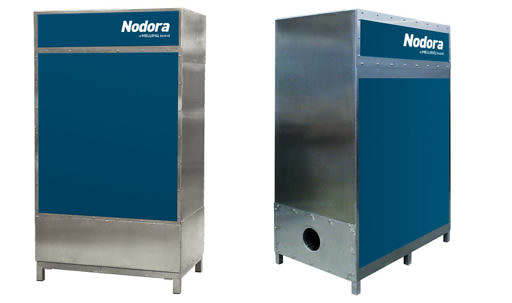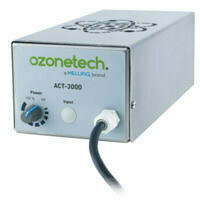Request a qoute.

Our vision for the modern commercial kitchen
Operating a modern commercial kitchen in an efficient way requires a high standard on all the elements involved. From having the right equipment, a well functioning work environment, organization and logistics, to keeping the entire kitchen clean and sanitary, all factors need to be in place. One of the most important elements in a commercial kitchen is the air quality. The air quality depends on the ventilation system and how the exhaust air is treated. Neglect one important detail, and the kitchens operation may run into difficulties which consequently will effect the business.
Our vision for the modern commercial kitchen is a kitchen that has a high level of fire safety, offers a better working environment, does not release odors in the kitchen, within the property nor its surroundings, has lower maintenance costs and above all: the heat in the exhaust air, from the griddles, frying pans, ovens and deep fryers, is taken advantage of. In short, we vision a nicer, safer and more sustainable kitchen operation. The ventilation system in a kitchen serves to dissipate heat, moisture, grease, cooking fumes, and to provide a fresh air supply.
According to an estimate, there are over 13 million restaurants in the world and 25,000 of them are located in Sweden – and this number is increasing rapidly. The majority of all restaurants discharge hot air that is not treated accordingly. As much as half of the energy consumed by a kitchen establishment dissipates in the form of heat through the exhaust ventilation. Significant energy savings can be made if this heat energy is taken advantage of, instead of released through the ventilation. However, utilizing the heat requires that the exhaust air is properly treated; otherwise, the maintenance of filters, heat exchangers and the channel itself becomes too burdensome and costly.

Common challenges in commercial kitchens.
Improving fire safety
Above 40% of all fires in real estate originate from a kitchen
Three factors are required for a fire to occur; fuel, oxygen (air) and heat. All three factors are present in a commercial kitchen hood and exhaust duct, that is filled with greasy, high energy exhaust air generated from e.g. woks, deep fryers and/or griddles. Remove one factor and the fire hazard is reduced significantly.
Approximately 40% of all restaurant and hotel fires originate from the kitchen where about half of the fires start on the stove. In addition to the risk of injury, the cost of property and material damage is significant, often more than EUR 50 000 per restaurant. It also leads to further expenses due to loss of revenue while the restaurant is closed for repairs. The insurance may, or may not, cover this lost revenue.
Common causes of kitchen fires
- Too high temperatures in the deep fryer
- Highly flammable vegetable oils
- Old, more flammable oil in the deep fryer
- Fat deposits in the flue and ventilation ducts
- Misaligned sprinklers due to equipment on wheels being moved around
- Malfunctioning sprinklers due to the fusible links being clogged by grease
Optimizing heat recovery
Purify the kitchen exhaust air and recycle tens of thousands of euros every year
Greasy and dirty exhaust air is associated with costs. If purified, it would be a valuable resource. A restaurant with about 1 500 m3/h exhaust air loses up to 14 000 euros per year in heat energy depending on the operating conditions. The payback period for an air purification system and a heat recovery unit can be as short as a few years. Kitchen ventilation is needed in order to create a good working environment in the kitchen, to dissipate heat as well as cooking odors and moisture and to supply the area with fresh air. However, in Sweden alone, an estimated 280 million euros disappear in the form of heat energy through the ventilation of our properties. There are ongoing projects designed to make commercial kitchens more energy efficient. Energy savings can be achieved by selecting the right equipment, utilizing demand-controlled ventilation, correct service intervals of the equipment and training of staff. The (heat) energy in the exhaust air from a kitchen constitutes the largest part of the possible energy savings by far – probably as much as 40% of the total energy consumption in a kitchen.
An average-sized kitchen can save tens of thousands of euros annually by taking measures that allow heat recovery from the exhaust air with a heat exchanger. Start to purify the air and installing a heat exchanger. Already at moderate thermal efficiencies, the potential savings are significant.
Odor control
Prevent discomfort for employees, guests and neighbors
The ventilation system in a kitchen serves to dissipate heat, moisture, grease, cooking fumes and to provide a fresh air supply. Cooking fumes contain a large variety of compounds that yield odors (odor molecules). Rancid fat deposits may also contribute to bad odors through the exhaust air that can disturb nearby residents. Bacteria that thrive on fat-based compounds may also emit odorous compounds. The odor compounds from cooking are normally volatile organic compounds (VOCs) that, in contact with ozone, is oxidized to form water, carbon dioxide and some dust.
In addition to increased fire safety and efficient energy recovery, odor reduction is one of the main reasons for using ozone-based air purification.
- Continuous and reliable purification of air with ozone reduces the emission of cooking fumes considerably. This leads to a reduced risk of complaints from neighbors who may be disturbed by the smell.
- Requirements for odor reduction are much greater if the exhaust duct is positioned close to residential buildings. In these cases, a complete odor treatment solution should be considered.
If a restaurant business receives complaints about bad odors, the municipality may require that measures are taken in order to be allowed to continue the business. In urban areas, ozone purification of exhaust air may be the difference between obtaining permission or not for running a restaurant business.
Lowering operating costs
From the business side of a commercial kitchen, the ability to save energy by maximizing heat recovery, while reducing the costs of handling (purchasing, transporting, storing and waste managing) chemicals are of huge importance. Other costs that can impact the kitchen’s economy are costs for manual cleaning of the ducts. An efficient kitchen exhaust air treatment solution minimizes the cost of manual cleaning since the need for duct cleaning can be highly reduced.
Ozonetech RENA Kitchen Solutions is efficient and reliable with low operating costs and minimal maintenance requirements.
Energy consumption for different buildings

Reducing environmental impact
Using ozone to treat the kitchen exhaust air is a sustainable solution. Ozone is produced onsite from the ambient air – a free of charge natural raw material. Nothing needs to be purchased, transported or managed. The Ozonetech ozone systems can continuously produce ozone by exposing the oxygen in the air to a high voltage field, using a technology called Corona Discharge. Ozone is produced with an extremely low environmental impact.
Ozone is also an unstable molecule, which means that it will spontaneously “revert” into oxygen-molecules if there is no available compound to oxidize. Ozone has a short half-life, especially when compared to other household cleaning chemicals e.g. sodium hypochlorite that has a half-life of several years depending on the ambient conditions.
With built-in purification, class 2b is sufficient
The Swedish regulation for ducts (Imkanal 2012:2) states that if a purification system, such as ozone purification or UV light, is installed in the duct system, a cheaper material can be used for the duct. Any large kitchen powered by electricity or gas classifies as Class 2B and can therefore use black plate or galvanized plate in the ducts instead of stainless steel. Thereby, if the kitchen exhaust is purified with ozone you can save 70-80% of the cost for duct material. The costs vary depending on the length of the duct, number of bends, cleaning hatches and dampers.
Using ozone as a purification method reduces grease in the exhaust air and therefore increases the fire safety. However, it is important to have a system that works properly and purifies the exhaust air continuously to maintain a fire-safe duct system.
Note that these classifications are specific to Sweden, and your country might have different rules and regulations.

Sustainable and efficient solutions for treating commercial kitchen exhaust air.
An important step towards a modern kitchen is the efficient treatment of the hot, odorous and greasy kitchen exhaust air. Efficiently and properly treated exhaust air yield many benefits, such as; improved fire safety, optimized heat recovery, odor control, lower operational costs, cheaper duct material and an environmentally friendly solution. Mellifiq offers a variety of solutions to properly remove grease and odors in the kitchen exhaust where a high treatment capacity is required. Ozonetech RENA Kitchen Solutions is a high-performance ozone system, and the right solution for treating the exhaust air from a commercial kitchen. Ozonetech RENA Kitchen Solutions can be combined with Mellifiq’s efficient Nodora odor removal solutions in cases with extra high requirements; for example, where potential odor problems may limit the scope of a kitchen design or revoke the permission to run a commercial kitchen.
Shopping mall - Recycling heat from the food court
Ozonetech RENA Kitchen Solutions
Ozonetech RENA Kitchen Solutions is Mellifiq’s most powerful system solution developed for commercial kitchens and restaurants, serving one or several hoods. The Ozonetech RENA system can provide ozone to several kitchens and hoods and be placed adjacent to the kitchen, or preferably further away from the kitchen in a separate room. The level of safety is high. Ozone production shuts down immediately if something out of the ordinary occurs. The system is monitored by our Service Center that gets alarm notifications if something is wrong and they can remotely restart the system when needed.
Ozonetech RENA Kitchen Solutions has a very low operating cost and the maintenance requirements are minimal. The raw material (ambient air) is free. Nothing needs to be purchased, transported, stored or managed. You avoid moving parts, mechanical cleaning, fillings, waste and residues.
Technical specifications
Ozonetech RENA Kitchen Solutions are fed with dry, pure oxygen and cooled with liquid. It is a very efficient and reliable technology to produce ozone. Day after day, year after year, purification capacity is constant. Ozone production is steplessly adjustable and easy to change. A single Ozonetech RENA system is capable of producing enough ozone for multiple hoods, large airflows and high grease loads. Ozonetech RENA Kitchen Solutions is available in seven models for different air flows. The ozone system components are mounted on a stainless steel plate simplifying installation.

Benefits of treating exhaust air with ozone
Lower risk of fire
Fat deposits in the exhaust ducts is one of the greatest threats to a commercial kitchen. Grease is flammable, burning at high temperatures and can lead to large, uncontrollable fires that are difficult to extinguish. Consequently, all exhaust ducts in restaurants and commercial kitchens should be regularly cleaned to minimize the fire hazard. An immediate result of continuous ozone treatment of greasy kitchen exhaust air is that fire safety is significantly improved. The ozone treatment prevents the formation of fat deposits in the ducts by breaking down the grease whilst airborne. This removes the fuel needed for a fire to start. This also reduces the amount of manual cleaning of the inner parts of the duct and lowers the frequency of replacements of particle filters.
Less frequent duct cleaning is needed
The frequency of exhaust duct cleaning is commonly determined by the local municipality and usually regulated by the safety/fire code in order to prevent chimney and kitchen flue fires. The duct cleaning process depends on the layout of the ventilation system. In the manual cleaning, typically the duct, fan and ventilation unit are sprayed with hot water and grease solvent to remove flammable fat deposits.
Ozone is an efficient tool to chemically decompose grease particles and aerosols in the air and convert them to carbon dioxide, water and a small amount of dust that is transported through the exhaust duct without adhering to the inner walls. Similar to how a scissor cuts a fine thread, the ozone “cuts” the organic (carbon) chains in the fat molecules. The interior of the exhaust duct and pre-filter can therefore remain clean from fat deposits, which drastically lowers the need for duct cleaning.
Lower environmental impact
All Ozonetech ozone systems generate ozone onsite by converting the oxygen from ambient air. The energy use is minimal compared to traditional chemical-based treatment methods. The use of less energy and chemicals lowers the environmental impact of the kitchen significantly compared to other purification methods. No frequent purchases, transport, storage, replenishment and handling of chemicals/bacteria. The only requirement is electricity and the ambient air.
Business values of ozone treatment
Treating the kitchen exhaust with ozone enables savings such as:
- Heating costs, up to 80%
- Manual duct cleaning costs, occurs less frequently, which also means less downtime for the business
- Total energy consumption costs, lowered by up to 30%!
In general, the overall economy of a property (sometimes even for the tenants) gains hugely from utilizing high-class ozone treatment systems, offered by Mellifiq. You gain from:
- Optimized heat recovery that lowers your energy costs
- Less usage of chemicals, and thereby lower costs. Ozone is produced on-site from ambient air. This means that no more frequent purchasing, transporting, storing, handling and wasting chemicals or bacteria is required.
- Less duct cleaning, the frequency of mandatory duct cleaning sessions is minimized when the grease is removed before it sticks to the surface of the ducts.
- Other general maintenance costs, involved with traditional treatment methods, such as cost of time spent on cleaning.
Recommended products
Ozonetech RENA Kitchen solution
The Ozonetech RENA Kitchen solution segment offers the following operational enhancements:
- Plug and play turn-key ozone-based air-treatment solution of kitchen exhaust air
- Multiple options and highly customizable ozone production and distribution
- Supports one or multiple hoods and air-handling units (AHU)
- High treatment capacity for large airflows and demanding grease loads in the exhaust air
- Efficient ozone output, reducing energy consumption and environmental footprint
- State of the art design resulting in very stable performance over time
- Integrated solution with automation, sensors and controls
- A very efficient and reliable system for exhaust air treatment
- Covering a wide range of treatment requirements for different air flows
- Low cost of operation and low maintenance
- Reduces use of chlorin-based chemicals
- Ready for shipment across the globe

Recommended products
Nodora
- Advanced catalyzing and adsorption systems
- Lowest pressure drop on the market
- Modularized design
- Even air flow distribution over filter beds
- Easily tailor-made
- Cassette-based design for smoothest possible maintenance

Recommended products
ACT-Series
The ACT segment offers the following operational enhancements:
- Easy to use and cost-efficient option
- Reduce energy requirements by replacing chemicals with ozone sanitation
- Efficiently removes odors at a low cost
- No handling of chemicals, transport and costs
- Chemical-free feed and process water quality assurance

More about ozone treatment
Ozone is a strong oxidant (like chlorine) that effectively breaks down smaller fat particles and gaseous fats in the exhaust air and on the surfaces in the exhaust ventilation. Ozone oxidizes fat to generate water, carbon dioxide and some dust. Ozone treatment allows for continuous purification of the exhaust air when the kitchen ventilation is operating. Ozone is generated onsite by reliable systems that require minimal maintenance. Read more about our solutions and systems here. Efficient and continuous removal of grease and fats in the exhaust air yield many benefits. Fire safety increases considerably, odors are reduced and cleaning of the ventilation ducts is required less frequently, and manual cleaning takes significantly less time. Our ozone systems require low maintenance and supervision, and the return of investment is often as short as two to three years if the heat is recovered properly.
More about fire safety
Fire extinguishing system
The safest way to protect a restaurant from fire hazards in the kitchen and the ducts is to install a fire suppression system over the entire area of cooking equipment and in the kitchen hoods.
Fires involving cooking oils are classified as “Class K” in the United States, and “Class F” in European and Australian systems. The most commonly used agent for K/F class fires is wet chemical fire extinguisher, which is mostly potassium salts mixed with water.
The most reliable systems are based on “saponification”, a process that produces glycerol and fatty acid salt, called “soap”. The reaction is a certain fire extinguisher to fight hot cooking oil and fat fires. The reaction both cools down the oil, removing some of the heat, and shuts out the oxygen supply to the fuel. The primary purpose is to protect the kitchen staff and reduce the risk of the fire spreading further.
Regular supervision
Stainless steel ducts are expensive, but also the safest in terms of fire prevention. This is because of the high temperature resistance of stainless steel, which allows it to withstand the high temperatures that occur, for example, during a fire spreading through fat deposits in the ventilation duct. A kitchen exhaust duct with a built-in purification system, such as ozone treatment or UV-lamps, poses a lower risk of fire, which may allow for cheaper materials than stainless steel to be used (depending on your country’s regulations and recommendations regarding fire prevention). Additionally, the need for duct cleaning decreases because grease particles are continuously removed from the exhaust air.
How often the channel needs inspection and cleaning must be decided on a case by case basis.
More about heat recovery
In purely theoretical terms, how do you recover the greatest amount of energy?
Here are a few tips on how to recover the maximum amount of energy:
- Buy a high-quality heat exchangerPut time and energy into your choice of the heat exchanger. Choose a reliable model with a high efficiency rating, and then make sure to keep it clean to prevent it from losing efficiency. It must be able to work under ideal conditions – at all times. Only then will you be able to recover the maximum amount of energy year after year.
- Remove as much grease as possible before the air reaches the heat exchangerMake sure the air that reaches the pre-filter of the heat exchanger is as clean as possible at all times. This is important since large amounts of grease have a number of negative effects. The grease may cause pressure drops in the exhaust duct, and the efficiency of the heat exchanger is reduced. Heating costs increase, the pre-filter needs replacing more often and the heat exchanger has to be cleaned more frequently.
- Understand the advantages and drawbacks of the various technical solutions -and make the right decisionThe hot grease-laden air travels at 3–5 m/s on its way to the heat exchanger. Choose the method that most effectively removes the billions of small grease particles and aerosols that rush through the air stream. Additionally, choose the solution that manages to keep the exhaust duct clean at all times.
Set high demands on the treatment solution
The purpose of the treatment solution is to minimize the amount of grease that reaches the heat exchanger. These are the requirements we think should be met by a really good solution:
- It must remove a high proportion of the grease particles and aerosols in the air stream
- Any reduction in treatment capacity over time must be no more than marginal
- The need for service, maintenance and other continuous handling must be minimal
- The treatment solution must not be the cause of operating outages, pressure drops or generally impact the ventilation as a whole
- The treatment must be efficient enough to make sure that the exhaust duct rarely requires manual cleaning
- It must be easy to reduce and increase the treatment capacity
Avoid active and moving parts in the exhaust duct and hood
We strongly recommend refraining from using any active or moving parts in the exhaust duct and hood. If equipment is positioned in the contaminated air flow, treatment capacity will be reduced quicker, and it will require more cleaning, maintenance and replacement of spare parts.
A highly energy-efficient commercial kitchen requires that a combination of factors is properly incorporated.
Studies show that the majority of potential savings can be derived from the five aspects described below, and taking action on these give the highest profit:
- Technology in the kitchen – choose equipment and tools with low energy consumption and/or demand-controlled operation
- Ventilation – use demand-controlled ventilation, purify the exhaust air and recover heat from the purified air
- Cooling: refrigerators, freezer rooms etc. / Replace cooling where possible e.g. garbage rooms
- Maintenance – regular maintenance of equipment allows their energy efficiency to remain high and constant. This leads to lower energy consumption
- Staff – educate the staff! The efficiency and use of equipment by the kitchen staff have a large impact on the energy consumption
More about odor problems
Restaurant closes due to neighbors’ odor complaints
A small complaint from neighbors due to cooking odors can grow into an unmanageable problem. Odors are something highly subjective and complaints from the neighbors due to cooking odors are never good for business. In a worst-case scenario, the landlord or authorities become involved inevitably forcing the restaurant to close. However, odors are a difficult field due to the lack of good benchmarks or instruments for detecting/ measuring them. This means that authorities are often forced to make an assessment based on a subjective perception of the smell. A certain smell may be allowed to occur, but it is always on a case-by-case basis depending on the intensity, duration, frequency, time of day and more. If the authorities consider the smell unacceptable they may demand action.
Problems regarding smell won’t go away by themselves as long as the source and conditions remain unchanged. Actions are required and ozone treatment can be used for odor reduction, eliminating or at least limiting the problem.
A bureaucratic term may be “interference” or “nuisance”, but we are essentially talking about a bad odor. Firstly, the complaints are addressed to the property owner and/or restaurant owner (they usually have a shared responsibility). If the complaints are ignored, the next instance is usually the authorities.
Therefore, it is important to take a number of factors into account during the design phase:
- Are there residents in the vicinity of the restaurant?
- Where is the exhaust air discharged from the kitchen?
- Type of cooking?
Apply to one of our free courses through Ozone Academy to learn more about how to lower the operational costs while maximizing the purification of the kitchen exhaust.
Nodora odor removal
Nodora is one of Mellifiq’s established product brands, a series of in-house developed filtration systems for advanced air treatment, and far more efficient than traditional solutions for any type of odor problems. The Nodora ADS-series and Nodora AirKarb series are perfect complements to an Ozonetech RENA kitchen solution to achieve the high-efficiency purification needed to treat large and heavily polluted flows.
The various filtration systems under our Nodora brand are designed to fit most common ventilation applications and are constructed as a modular system to enable scalable and high efficient odor removal. Depending on airflow, the degree of pollution and requirements, Nodora is easy to scale up.
In addition, all Nodora solutions are designed to operate with minimal pressure drop to broaden the number of application areas without the need for replacing existing fans or generators. A combination of Ozonetech RENA Kitchen Solutions and Nodora allows for more opportunities during the design phase of a commercial kitchen establishment. Odorous exhaust air can be treated to such levels that the odorless warm air can be discharged into even sensitive areas such, as residential areas, ground-level shopping malls, below ground level garage and similar.
Reference projects – odor removal
Odors and odor problems are complex and a science in its own right. To remove 50% of the odorous compounds in the kitchen exhaust is rarely representative of 50% removal of the perceived odor.
All odor compounds have their own unique odor threshold (the level at which it can be perceived) and odor intensity. With more than 25 years of experience and in-depth research, we are currently able to deliver odor removal solutions that are tailor-made to each project’s own specifications and requirements.
For more information, learn more about Nodora.
More about cheaper duct material
It is always the projector who is responsible for the design, dimensioning and function of the plant. Based on this and in consultation with the client and possibly also the user, the projector should choose the appropriate execution of the duct according to the needs of the business. The projector should consider the nature of the business and what is appropriate to conduct on the premises, and also what possible change in the business on the premises is conceivable. He should also investigate if there are suitable spaces for fan rooms and ventilation installation throughout the building, including exhaust air function. It is also advisable to make choices so that a change of business requires only minor intervention in the ventilation system and in the building. In addition, the projector should find out what type of organization exists around the restaurant business, as some installation components may need continuous and properly performed maintenance to maintain the intended function.
The following classification provides examples of operations within the five material classes that the industry considers reasonable. They should not be regarded as definitive and do not relinquish the projector’s responsibility.
Class 1A – For all types of cookingClass 1B – With extinguishing systemClass 2A – For heating kitchens etc.Class 2B – With built-in purificationClass 3 – Housing, office, etc.
Note that these classifications are specific to Sweden, and your country might have different rules and regulations.
Related reference project.

Final odor treatment and energy recovery in new city center nightclub

The odors from the charcoal grill no longer disturb the offices
Sign up for Mellifiq Academy – We share our knowledge
Mellifiq Academy hosts courses designed specifically for property owners, technical consultants, ventilation contractors, restaurant owners, duct cleaners and others who want basic knowledge about ozone treatment.
Sign up for one of our free courses through the Mellifiq Academy to learn more about how to lower the operational costs while maximizing the purification of the kitchen exhaust.
Read more about ozone here. If you want to deepen your knowledge about ozone treatment, feel free to sign up for one of our free courses through Mellifiq Academy!
Read more here and sign up today!







